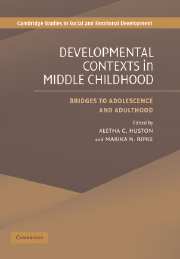Book contents
- Frontmatter
- Contents
- Contributors
- Foreword
- Acknowledgments
- 1 Middle Childhood: Contexts of Development
- 2 The Significance of Middle Childhood Peer Competence for Work and Relationships in Early Adulthood
- 3 Aggression and Insecurity in Late Adolescent Romantic Relationships: Antecedents and Developmental Pathways
- 4 Middle Childhood Family-Contextual and Personal Factors as Predictors of Adult Outcomes
- 5 Genetic and Environmental Influences on Continuity and Change in Reading Achievement in the Colorado Adoption Project
- 6 Reciprocal Effects of Mothers' Depression and Children's Problem Behaviors from Middle Childhood to Early Adolescence
- 7 Middle Childhood Life Course Trajectories: Links Between Family Dysfunction and Children's Behavioral Development
- 8 The Contribution of Middle Childhood Contexts to Adolescent Achievement and Behavior
- 9 Educational Tracking Within and Between Schools: From First Grade Through Middle School and Beyond
- 10 School Environments and the Diverging Pathways of Students Living in Poverty
- 11 The Relations of Classroom Contexts in the Early Elementary Years to Children's Classroom and Social Behavior
- 12 Out-of-School Time Use During Middle Childhood in a Low-Income Sample: Do Combinations of Activities Affect Achievement and Behavior?
- 13 Low-Income Children's Activity Participation as a Predictor of Psychosocial and Academic Outcomes in Middle Childhood and Adolescence
- 14 Healthy Mind, Healthy Habits: The Influence of Activity Involvement in Middle Childhood
- 15 Media Effects in Middle Childhood
- 16 Continuity and Discontinuity in Middle Childhood: Implications for Adult Outcomes in the UK 1970 Birth Cohort
- 17 Mandatory Welfare-to-Work Programs and Preschool-Age Children: Do Impacts Persist into Middle Childhood?
- 18 Effects of Welfare and Employment Policies on Middle-Childhood School Performance: Do They Vary by Race/Ethnicity and, If So, Why?
- 19 Effects of a Family Poverty Intervention Program Last from Middle Childhood to Adolescence
- 20 Experiences in Middle Childhood and Children's Development: A Summary and Integration of Research
- Author Index
- Subject Index
- References
12 - Out-of-School Time Use During Middle Childhood in a Low-Income Sample: Do Combinations of Activities Affect Achievement and Behavior?
Published online by Cambridge University Press: 16 September 2009
- Frontmatter
- Contents
- Contributors
- Foreword
- Acknowledgments
- 1 Middle Childhood: Contexts of Development
- 2 The Significance of Middle Childhood Peer Competence for Work and Relationships in Early Adulthood
- 3 Aggression and Insecurity in Late Adolescent Romantic Relationships: Antecedents and Developmental Pathways
- 4 Middle Childhood Family-Contextual and Personal Factors as Predictors of Adult Outcomes
- 5 Genetic and Environmental Influences on Continuity and Change in Reading Achievement in the Colorado Adoption Project
- 6 Reciprocal Effects of Mothers' Depression and Children's Problem Behaviors from Middle Childhood to Early Adolescence
- 7 Middle Childhood Life Course Trajectories: Links Between Family Dysfunction and Children's Behavioral Development
- 8 The Contribution of Middle Childhood Contexts to Adolescent Achievement and Behavior
- 9 Educational Tracking Within and Between Schools: From First Grade Through Middle School and Beyond
- 10 School Environments and the Diverging Pathways of Students Living in Poverty
- 11 The Relations of Classroom Contexts in the Early Elementary Years to Children's Classroom and Social Behavior
- 12 Out-of-School Time Use During Middle Childhood in a Low-Income Sample: Do Combinations of Activities Affect Achievement and Behavior?
- 13 Low-Income Children's Activity Participation as a Predictor of Psychosocial and Academic Outcomes in Middle Childhood and Adolescence
- 14 Healthy Mind, Healthy Habits: The Influence of Activity Involvement in Middle Childhood
- 15 Media Effects in Middle Childhood
- 16 Continuity and Discontinuity in Middle Childhood: Implications for Adult Outcomes in the UK 1970 Birth Cohort
- 17 Mandatory Welfare-to-Work Programs and Preschool-Age Children: Do Impacts Persist into Middle Childhood?
- 18 Effects of Welfare and Employment Policies on Middle-Childhood School Performance: Do They Vary by Race/Ethnicity and, If So, Why?
- 19 Effects of a Family Poverty Intervention Program Last from Middle Childhood to Adolescence
- 20 Experiences in Middle Childhood and Children's Development: A Summary and Integration of Research
- Author Index
- Subject Index
- References
Summary
The middle childhood years are characterized by numerous biological, psychological, and social changes (Eccles, 1999). During this period, children master fundamental academic skills such as reading and arithmetic and they also become more self-aware, reflective, and planful. Erikson (1968) characterized this phase of life as a time of “industry,” with attention directed at gaining competencies in a variety of tasks and learning how to cooperate with peers and adults. In contrast to children's very early years, when the influence of proximal family contexts is paramount, the middle childhood years represent a time of increasing influences of out-of-home environments. Although the family remains important for children's well-being, children at this age increasingly participate in organized programs and interact with peers in their community or neighborhood; they are also more influenced by teachers, school environments, and peer groups.
Low-income children face several challenges to successful development during this stage of life, and some of these challenges stem from the limitations or outright dangers inherent in their out-of-home environments (Leventhal & Brooks-Gunn, 2000). Physically dangerous neighborhoods (i.e., those in which children experience high levels of victimization) may force children to be isolated in their homes, restricting opportunities for interactions with peers and adults. Less-advantaged neighborhoods also provide fewer enriching opportunities such as parks, libraries, and children's programs.
Just as high quality child care opportunities can boost the development of young children in poverty, researchers have suggested that high quality out-of-school programs can augment the development of children during middle childhood.
- Type
- Chapter
- Information
- Developmental Contexts in Middle ChildhoodBridges to Adolescence and Adulthood, pp. 237 - 259Publisher: Cambridge University PressPrint publication year: 2006
References
- 9
- Cited by



